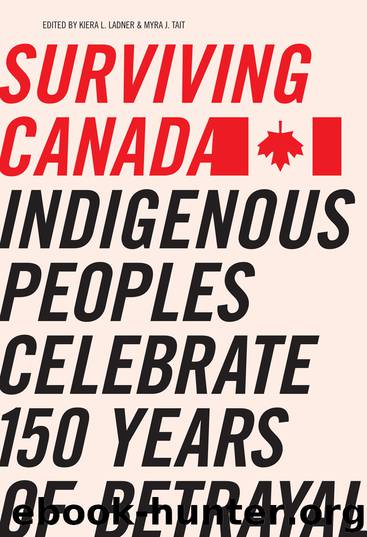Surviving Canada by Kiera L. Ladner

Author:Kiera L. Ladner
Language: eng
Format: epub
Publisher: Arbeiter Ring Publishing
“Aw what could I do?” say a powerful few
with a lump in your throat and a tear in your eye:
Can’t you see that their poverty’s profiting you?
My country ‘tis of thy people you’re dying.
Reconciliation on Trial
Evaluating What Reconciliation Means in the Context of Aboriginal Justice
David Milward
The past horrors of the Canadian Indian residential schools, and the social legacies they have left behind, are perhaps well enough known in Canadian academic and political circles. Growing awareness of the fallout from residential schools made it at least politically expedient enough for then Prime Minister Stephen Harper to offer the following apology: “Today, we recognize that this policy of assimilation was wrong, has caused great harm and has no place in our country . . . The government of Canada sincerely apologizes and asks the forgiveness of the aboriginal peoples of this country for failing them so profoundly. We are sorry.”1 The apology, plus lawsuits,2 from the survivors of the residential schools, contributed to the formation of the Truth and Reconciliation Commission of Canada (TRC). The TRC released its final report in 2015, which detailed and chronicled the harms inflicted by the residential schools, as well as exploring ways to address the social catastrophe that has been left behind.3 The very term “reconciliation” presupposes that Aboriginal peoples remain part of Canada, but that the relationship between Aboriginal peoples and non-Aboriginal Canadians needs to change on very fundamental levels.
It is a sad coincidence that the 150th anniversary of the Constitution Act, 18674 and the release of the final report of the TRC are a mere two years apart, as both events invite profound questions about the place of Aboriginal peoples within the nation-state that is called Canada. And indeed different Aboriginal thinkers have come to different responses to those questions.
Taiaiake Alfred, for example, is of the view that the only satisfactory resolution for Aboriginal peoples is to become their own completely independent polities, separate from Canada.5 He also views reconciliation absent of a massive restitution of land and economic resources as “an emasculating concept, weak-kneed and easily accepting of half-hearted measures of a notion of justice that does nothing to help Indigenous peoples regain their dignity and strength.”6 At the risk of placing words in someone else’s mouth, it may be reasonable to conjecture that Alfred would reject the 150th anniversary as something to be celebrated.
Others have taken more moderate views, including the TRC itself. The final report of the TRC calls for Canada to develop a Royal Proclamation of Reconciliation in consultation and partnership with Aboriginal peoples. This royal proclamation would recognize Aboriginal peoples as “full partners in Confederation,” establish a nation-to-nation relationship between Aboriginal peoples and Canada, and would involve the “recognition and integration of Aboriginal laws and legal traditions.”7 John Borrows argues that the depiction of Canada as founded by two legal traditions, common law and civil law, is inaccurate because it fails to recognize Aboriginal legal traditions as a third and equally important legal foundation for the formation of Canada.
Download
This site does not store any files on its server. We only index and link to content provided by other sites. Please contact the content providers to delete copyright contents if any and email us, we'll remove relevant links or contents immediately.
| Anthropology | Archaeology |
| Philosophy | Politics & Government |
| Social Sciences | Sociology |
| Women's Studies |
Cecilia; Or, Memoirs of an Heiress — Volume 1 by Fanny Burney(32396)
Cecilia; Or, Memoirs of an Heiress — Volume 3 by Fanny Burney(31791)
Cecilia; Or, Memoirs of an Heiress — Volume 2 by Fanny Burney(31763)
The Great Music City by Andrea Baker(31233)
We're Going to Need More Wine by Gabrielle Union(18932)
All the Missing Girls by Megan Miranda(15455)
Pimp by Iceberg Slim(14279)
Bombshells: Glamour Girls of a Lifetime by Sullivan Steve(13946)
Talking to Strangers by Malcolm Gladwell(13167)
Norse Mythology by Gaiman Neil(13160)
Fifty Shades Freed by E L James(13140)
For the Love of Europe by Rick Steves(12514)
Crazy Rich Asians by Kevin Kwan(9143)
Mindhunter: Inside the FBI's Elite Serial Crime Unit by John E. Douglas & Mark Olshaker(9139)
The Lost Art of Listening by Michael P. Nichols(7377)
Enlightenment Now: The Case for Reason, Science, Humanism, and Progress by Steven Pinker(7127)
The Four Agreements by Don Miguel Ruiz(6572)
Bad Blood by John Carreyrou(6510)
Weapons of Math Destruction by Cathy O'Neil(6105)
